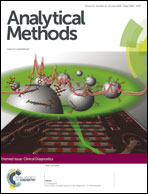Electrodes/paper sandwich devices for in situ sensing of hydrogen peroxide secretion from cells growing in gels-in-paper 3-dimensional matrix
Abstract
In the present study, a carbon paper electrode (CPE)/cells-in-paper/CPE sandwich device was developed for the in situ detection of small molecules produced from cells growing in paper 3 dimensional matrix. To demonstrate the real-time assay capability of the electrodes/cells-in-paper sandwich device, carbon nanotube/graphene/MnO2 nanocomposite was synthesized to functionalize the working electrode. Scanning electron microscopy, transmission electron microscope and X-ray photoelectron spectroscopy characterization proved that MnO2 nanoparticles were uniformly distributed on nanotube sidewalls and graphene sheets. The carbon nanotube/graphene/MnO2 nanocomposite functionalized electrode/cells-in-paper sandwich device showed specific response against hydrogen peroxide. The fully assembled device displayed a linear range up to 25 mM with a sensitivity of 6.25 μA mM−1 cm−2 and a detection limit of 6.7 μM hydrogen peroxide. In addition, in situ detection of hydrogen peroxide production from cells growing in matrigel impregnated paper was successfully demonstrated on the electrodes/cells-in-paper sandwich device, highlighting the potential application of this low-cost paper analytical device for cell biology studies.


 Please wait while we load your content...
Please wait while we load your content...